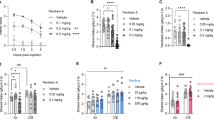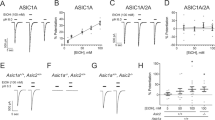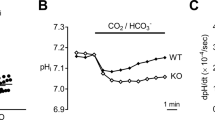Abstract
Ethanol affects many functions of the brain and peripheral organs. Here we show that ethanol opens G-protein-activated, inwardly rectifying K+ (GIRK) channels, which has important implications for inhibitory regulation of neuronal excitability and heart rate. At pharmacologically relevant concentrations, ethanol activated both brain-type GIRK1/2 and cardiac-type GIRK1/4 channels without interaction with G proteins or second messengers. Moreover, weaver mutant mice, which have a missense mutation in the GIRK2 channel, showed a loss of ethanol-induced analgesia. These results suggest that the GIRK channels in the brain and heart are important target sites for ethanol.
This is a preview of subscription content, access via your institution
Access options
Subscribe to this journal
Receive 12 print issues and online access
$209.00 per year
only $17.42 per issue
Buy this article
- Purchase on Springer Link
- Instant access to full article PDF
Prices may be subject to local taxes which are calculated during checkout






Similar content being viewed by others
References
Hobbs, W. R., Rall, T. W. & Verdoorn, T. A. in Goodman & Gilman's The Pharmacological Basis of Therapeutics 9th edn. (eds. Hardman, J. G., Limbird, L. E., Molinoff, P. B., Ruddon, R. W. & Gilman, A. F.) 361–396 (McGraw-Hill, New York, 1996).
Peoples, R. W., Li, C. & Weight, F. F. Lipid vs. protein theories of alcohol action in the nervous system. Annu. Rev. Pharmacol. Toxicol. 36, 185–201 (1996).
Covernton, P. J. O. & Connolly, J. G. Differential modulation of rat neuronal nicotinic receptor subtypes by acute application of ethanol. Br. J. Pharmacol. 122, 1661– 1668 (1997).
Mihic, S. J. et al. Sites of alcohol and volatile anaesthetic action on GABA A and glycine receptors. Nature 389, 385–389 (1997).
Wick, M. J. et al. Mutations of γ-aminobutyric acid and glycine receptors change alcohol cutoff: evidence for an alcohol receptor? Proc. Natl. Acad. Sci. USA 95, 6504–6509 (1998).
Peoples, R. W. & Weight, F. F. Cutoff in potency implicates alcohol inhibition of N-methyl-D-aspartate receptors in alcohol intoxication. Proc. Natl. Acad. Sci. USA 92, 2825– 2829 (1995).
Lovinger, D. M. & White, G. Ethanol potentiation of 5-hydroxytryptamine3 receptor-mediated ion current in neuroblastoma cells and isolated adult mammalian neurons. Mol. Pharmacol. 40, 263–270 (1991).
Li, C., Peoples, R. W. & Weight, F. F. Alcohol action on a neuronal membrane receptor: evidence for a direct interaction with the receptor protein. Proc. Natl. Acad. Sci. USA 91, 8200–8204 (1994).
Treistman, S. N. et al. Effects of ethanol on calcium channels, potassium channels, and vasopressin release. Ann. NY. Acad. Sci. 625, 249–263 (1991).
Covarrubias, M. & Rubin, E. Ethanol selectively blocks a noninactivating K+ current expressed in Xenopus oocytes. Proc. Natl. Acad. Sci. USA 90, 6957–6960 (1993).
North, R. A. Drug receptors and the inhibition of nerve cells. Br. J. Pharmacol. 98, 13–28 ( 1989).
Ikeda, K., Kobayashi, T., Ichikawa, T., Usui, H. & Kumanishi, T. Functional couplings of the δ- and the κ-opioid receptors with the G-protein-activated K+ channel. Biochem. Biophys. Res. Commun. 208, 302–308 (1995).
Ikeda, K. et al. Comparison of the three mouse G-protein-activated K+ (GIRK) channels and functional couplings of the opioid receptors with the GIRK1 channel. Ann. NY. Acad. Sci. 801, 95–109 (1996).
Ikeda, K. et al. Functional coupling of the nociceptin/orphanin FQ receptor with the G-protein-activated K+ (GIRK) channel. Mol. Brain Res. 45, 117–126 ( 1997).
Reuveny, E. et al. Activation of the cloned muscarinic potassium channel by G protein βγ subunits. Nature 370, 143–146 (1994).
Brown, A. M. & Birnbaumer, L. Ionic channels and their regulation by G protein subunits. Annu. Rev. Physiol. 52, 197–213 (1990).
Doupnik, C. A., Davidson, N. & Lester, H. A. The inward rectifier potassium channel family. Curr. Opin. Neurobiol. 5, 268–277 (1995).
Kobayashi, T. et al. Molecular cloning of a mouse G-protein-activated K+ channel (mGIRK1) and distinct distributions of three GIRK (GIRK1, 2 and 3) mRNAs in mouse brain. Biochem. Biophys. Res. Commun. 208, 1166–1173 (1995).
Lesage, F. et al. Molecular properties of neuronal G-protein-activated inwardly rectifying K+ channels. J. Biol. Chem. 270, 28660–28667 (1995).
Patil, N. et al. A potassium channel mutation in weaver mice implicates membrane excitability in granule cell differentiation. Nat. Genet. 11, 126–129 ( 1995).
Wickman, K., Seldin, M. F., Gendler, S. J. & Clapham, D. E. Partial structure, chromosome localization, and expression of the mouse Girk4 gene. Genomics 40, 395– 401 (1997).
Karschin, C., Diβmann, E., Stuhmer, W. & Karschin, A. IRK(1–3) and GIRK(1–4) inwardly rectifying K+ channel mRNAs are differentially expressed in the adult rat brain. J. Neurosci. 16, 3559–3570 ( 1996).
Liao, Y. J., Jan, Y. N. & Jan, L. Y. Heteromultimerization of G-protein-gated inwardly rectifying K+ channel proteins GIRK1 and GIRK2 and their altered expression in weaver brain. J. Neurosci. 16, 7137–7150 (1996).
Krapivinsky, G. et al. The G-protein-gated atrial K+ channel I KACh is a heteromultimer of two inwardly rectifying K+-channel proteins. Nature 374, 135– 141 (1995).
Signorini, S., Liao, Y. J., Duncan, S. A., Jan, L. Y. & Stoffel, M. Normal cerebellar development but susceptibility to seizures in mice lacking G protein-coupled, inwardly rectifying K+ channel GIRK2. Proc. Natl. Acad. Sci. USA 94, 923–927 (1997).
Wickman, K., Nemec, J., Gendler, S. J. & Clapham, D. E. Abnormal heart rate regulation in GIRK4 knockout mice. Neuron 20, 103–114 ( 1998).
Lyon, R. C., McComb, J. A., Schreurs, J. & Goldstein, D. B. A relationship between alcohol intoxication and the disordering of brain membranes by a series of short-chain alcohols. J. Pharmacol. Exp. Ther. 218, 669–675 (1981).
Yan, K. & Gautam, N. A domain on the G protein β subunit interacts with both adenylyl cyclase 2 and the muscarinic atrial potassium channel. J. Biol. Chem. 271, 17597– 17600 (1996).
Devic, E. et al. The mRNA encoding a β subunit of heterotrimeric GTP-binding proteins is localized to the animal pole of Xenopus laevis oocyte and embryos. Mech. Dev. 59, 141– 151 (1996).
Slesinger, P. A., Stoffel, M., Jan, Y. N. & Jan, L. Y. Defective γ-aminobutyric acid type B receptor-activated inwardly rectifying K+ currents in cerebellar granule cells isolated from weaver and Girk2 null mutant mice. Proc. Natl. Acad. Sci. USA 94, 12210–12217 (1997).
Osmanovic, S. S. & Shefner, S. A. Ethanol enhances inward rectification in rat locus ceruleus neurons by increasing the extracellular potassium concentration. J. Pharmacol. Exp. Ther. 271 , 334–342 (1994).
Shefner, S. A. & Tabakoff, B. Basal firing rate of rat locus coeruleus neurons affects sensitivity to ethanol. Alcohol 2, 239–243 ( 1985).
Carlen, P. L., Gurevich, N. & Durand, D. Ethanol in low doses augments calcium-mediated mechanisms measured intracellularly in hippocampal neurons. Science 215, 306–309 (1982).
Lakhlani, P. P. et al. Substitution of a mutant α2a-adrenergic receptor via "hit and run" gene targeting reveals the role of this subtype in sedative, analgesic, and anesthetic-sparing responses in vivo. Proc. Natl. Acad. Sci. USA 94, 9950–9955 (1997).
Penna, M., Brugere, S., Canas, M. & Saavedra, A. Cardiorespiratory reflex effects induced by intravenus administration of ethanol in rats. Alcohol 2, 603–609 ( 1985).
Kobayashi, T., Ikeda, K. & Kumanishi, T. Effects of clozapine on the δ- and κ-opioid receptors and the G-protein-activated K+ (GIRK) channel expressed in Xenopus oocytes. Br. J. Pharmacol. 123, 421–426 (1998).
Hamill, O. P., Marty, A., Neher, E., Sakmann, B. & Sigworth, F. J. Improved patch clamp techniques for high-resolution current recording from cells and cell free patches. Pflugers Arch. 391, 85–100 ( 1981).
Ikeda, K. et al. Unique behavioural phenotypes of recombinant-inbred CXBK mice: Partial deficiency of sensitivity to μ- and κ-agonists. Neurosci. Res. 34, 149–155 (1999).
Ikeda, K. et al. Reduced spontaneous activity of mice defective in the ε4 subunit of the NMDA receptor channel. Mol. Brain Res. 33, 61–71 (1995).
Harris, R. A. et al. Mutant mice lacking the γ isoform of protein kinase C show decreased behavioral actions of ethanol and altered function of γ-aminobutyrate type A receptors. Proc. Natl. Acad. Sci. USA 92, 3658–3662 (1995).
Acknowledgements
We thank J. G. Connolly and R. Kado for critical reading of the manuscript, K. Sakimura, K. Shimoji, Y. Ishihara, T. Someya and K. Baba for their cooperation and H. Kishida, N. Yamazaki, T. Ichikawa and K. Kobayashi for their assistance. This work was supported by a research grant from the Ministry of Education, Science, Sports and Culture of Japan, by the Cooperative Research Program of the RIKEN Brain Science Institute and in part by Research for the Future Program from the Japan Society for the Promotion of Science.
Author information
Authors and Affiliations
Corresponding author
Rights and permissions
About this article
Cite this article
Kobayashi, T., Ikeda, K., Kojima, H. et al. Ethanol opens G-protein-activated inwardly rectifying K+ channels. Nat Neurosci 2, 1091–1097 (1999). https://doi.org/10.1038/16019
Received:
Accepted:
Issue Date:
DOI: https://doi.org/10.1038/16019
This article is cited by
-
Chemosensory representation of first-time oral exposure to ethanol in the orbitofrontal cortex of mice
Experimental Brain Research (2023)
-
GIRK1-Mediated Inwardly Rectifying Potassium Current Is a Candidate Mechanism Behind Purkinje Cell Excitability, Plasticity, and Neuromodulation
The Cerebellum (2020)
-
Role of GABAA receptors in alcohol use disorders suggested by chronic intermittent ethanol (CIE) rodent model
Molecular Brain (2017)
-
Dual activation of neuronal G protein-gated inwardly rectifying potassium (GIRK) channels by cholesterol and alcohol
Scientific Reports (2017)



